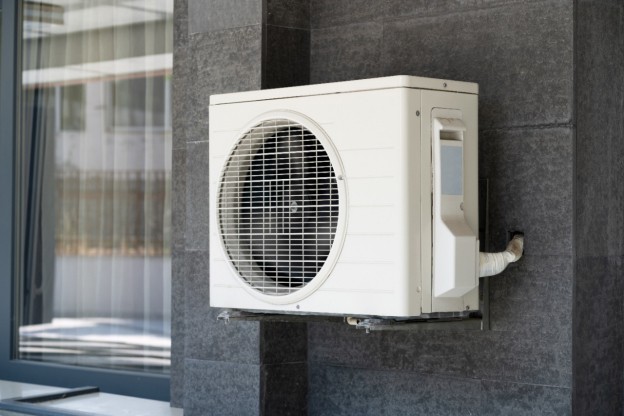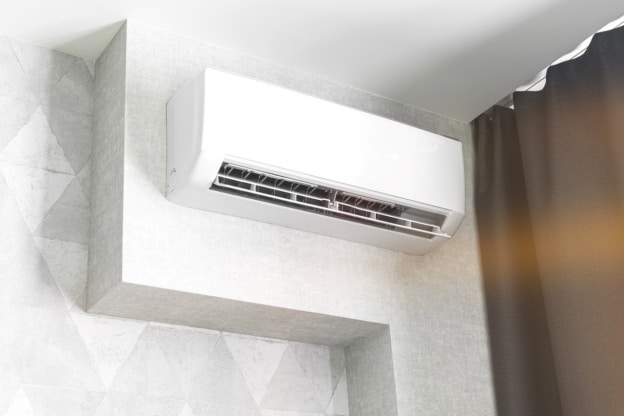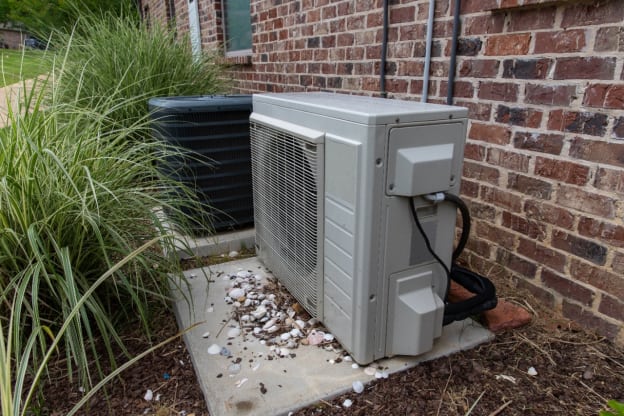Mini-split systems have been gaining popularity for their versatility and energy efficiency. Also known as ductless systems, these innovative solutions provide a compelling alternative to traditional central heating and cooling systems, but they’re not ideal for every home.
If you’re considering a ductless system, here’s our mini-split systems 101: the ultimate guide to ductless cooling and heating from the pros at HELP.
What Are Mini-Split Systems?
A mini-split system is a type of HVAC system that consists of two main components, an indoor unit and an outdoor unit. Unlike traditional HVAC systems, mini splits don’t rely on a network of ducts to distribute conditioned air. Instead, they use a conduit to connect the indoor and outdoor units, facilitating the transfer of refrigerant and electrical lines.
How Do Mini Splits Work?
Types of Mini-Split Systems
Mini splits come in a few different types:
- Wall-mounted units:Wall-mounted mini splits are the most commonly installed mini splits. They’re usually the simplest because they’re mounted high on the wall and out of the way. The capacity of wall-mounted units can range from 6,000 BTU to 24,000 BTU for multi-zoned indoors, and 6,000 BTU to 36,000 BTU for single-zoned systems.
- Floor-mounted units:Floor-mounted mini splits resemble radiators and are out of the way for people who don’t like the wall-mounted units. Their capacity ranges from 9,000 BTU to 18,000 BTU.
- Ceiling-cassette units:Ceiling-cassette mini splits are mounted in your ceiling and provide a more seamless look. They typically come in 2’x2’ recessed ceiling cassette, 3’x3’ recessed ceiling cassette, and one-way cassettes with a capacity that ranges from 9,000 BTU to 36,000 BTU for multi-zoned systems.
- Ceiling-suspended units:Ceiling suspended mini-splits are mounted from the ceiling and are typically used for commercial buildings. Their capacity ranges from 24,000 BTU to 42,000 BTU for single-zoned systems and 24,000 BTU for multi-zoned applications.
- Ducted units:Ducted mini splits are mounted in an attic or basement and use ductwork to move hot or cold air around your house. They’re usually used in tandem with other HVAC units. They come in low-static, mid-static, and high-static versions with a capacity of 9,000 BTU to 36,000 BTU for multi-zoned systems and 9,000 BTU to 42,000 BTU for single-zoned systems.
What Are Mini-Split Cooling and Heating Capabilities?

One of the main advantages of a mini-split system is the ability to provide both cooling and heating. The system’s reversible heat pump allows it to extract heat from the outdoor air and transfer it indoors during the cooler months, making it ideal for efficient year-round comfort.
What Are the Advantages of Mini-Split Systems?
Energy Efficiency
Mini-split systems are renowned for their energy efficiency. Traditional ducted systems can experience significant energy losses through ductwork, but mini splits eliminate this issue. The absence of ducts reduces energy waste, resulting in lower utility bills and a smaller environmental footprint.
Zoning Options
One of the standout features of a mini-split system is the zoning capability. Multiple indoor units can be connected to a single outdoor unit, each with its own thermostat. This allows you to customize the temperature in different areas of your home, optimizing your comfort and energy usage instead of arguing over the thermostat settings.
Flexible Installation
The installation process of mini-split systems is less involved than traditional HVAC systems. The absence of ductwork makes installation simpler and allows homes to be retrofit without the need for expensive renovations. Indoor units can be mounted on walls, ceilings, or even recessed into the ceiling for a discrete appearance.
Quiet Operation
Mini-split systems are known for their quiet operation. The indoor units are designed to operate at low noise levels, providing a peaceful and comfortable indoor environment. This is especially beneficial in bedrooms, living rooms, and other areas where it’s important to have a quiet environment.
Improved Indoor Air Quality

Ductless systems contribute to better indoor air quality by avoiding the circulation of air through ductwork, which can accumulate dust and allergens. In addition, many mini-split models come equipped with advanced filtration systems that capture and remove particles, providing a healthier living space.
Smart Thermostats and Connectivity
Modern mini-split systems often come equipped with smart thermostats that allow you to control and monitor your HVAC system remotely. Through smartphone apps or other smart home platforms, you can adjust the temperature settings, set a heating or cooling schedule, and receive updates on energy usage. The level of connectivity not only enhances convenience but also enables more precise control over energy consumption, contributing to better cost savings overall.
Advanced Filtration Systems
Indoor air quality is a growing concern. Mini splits are addressing this issue with advanced filtration systems that have multi-stage filters to capture dust, dirt, and debris, as well as allergens, bacteria, and even some viruses. This is especially important if you have family members with respiratory conditions or allergies that can be bothered by poor indoor air quality.
Energy-Saving Features
Mini splits are energy efficient on their own, but they may have additional energy-saving features like occupancy sensors and adaptive learning algorithms. Occupancy sensors can detect when a room is unoccupied and adjust the temperature accordingly, reducing energy consumption.
Installation Process
Sizing and Capacity
Proper sizing is crucial for the effectiveness of a mini-split system. An undersized unit may struggle to cool or heat the space, while an oversized unit can lead to short cycling, which is when the unit powers on and off quickly without completing a full cycle. This reduces efficiency over time. Factors like the room size, insulation, and local climate must be considered to determine the appropriate capacity.
Selecting Indoor Unit Types
Mini-split systems offer various indoor unit types, each catering to specific needs. Wall-mounted units are common and easy to install, while ceiling cassette units and concealed duct units provide a subtler appearance. The choice of an indoor unit depends on your personal aesthetic preferences, available space, and the desired level of visibility.
Positioning of the Outdoor Unit
The outdoor unit, which is often referred to as the condenser, should be strategically placed to ensure optimal performance. You need to make sure there’s proper clearance for airflow and position the unit away from obstructions that can impact heat exchange. Elevating the unit can prevent debris accumulation and facilitate drainage.
Refrigerant Lines and Conduit Installation
The conduit, which contains refrigerant lines, a power cable, and condensate drain, connects the indoor and outdoor units. Proper installation of the conduit is crucial for the system’s efficiency. The route should be planned to minimize bends and ensure a smooth flow. Also, the refrigerant lines must be adequately insulated to prevent energy loss.
Professional Installation
While mini-split systems are designed for simpler installation compared to traditional HVAC systems, it’s important to enlist the services of a qualified HVAC professional. Getting a professional installation ensures that the system is correctly sized, positioned, and connected to maximize its lifespan and efficiency.
Maintenance and Troubleshooting

Keeping your ductless system running its best requires regular maintenance and some occasional troubleshooting. Here’s everything you need to know:
Regular Cleaning
Maintaining a clean mini-split system is essential for efficient performance. Filters in the indoor units should be cleaned or replaced regularly to prevent the accumulation of dust and debris. Outdoor units may require occasional cleaning to remove dirt and ensure proper heat exchange.
Checking Refrigerant Levels
Low refrigerant levels can impair the system’s efficiency. Periodic checks from a qualified technician, like the technicians at HELP, can identify and address any refrigerant issues. Refrigerant leaks should be promptly repaired to prevent performance degradation and environmental harm.
Inspecting Electrical Components
Regular inspections of the electrical components, such as wiring and connections, can help identify potential issues before they escalate. Faulty electrical components can lead to system malfunctions, and in some cases, safety hazards.
Addressing Airflow Issues
Proper airflow is critical to the system’s efficiency. Blocked or obstructed air pathways can strain the system and reduce its performance. Regular checks for obstructions in both the indoor and outdoor units can prevent airflow issues.
Professional Maintenance
While some maintenance tasks can be performed by homeowners, scheduling professional maintenance at least once a year is recommended. A qualified technician can conduct a thorough inspection, address any potential problems, and ensure the system operates at peak efficiency.
Considering a Mini Split for Your Home?

Mini-split systems have revolutionized the way we approach heating and cooling in our homes. Their energy efficiency, flexibility, and ease of installation make them an ideal choice for people seeking a modern HVAC solution.
Is a mini split the right choice for your home? Contact us at HELP to schedule your consultation!


